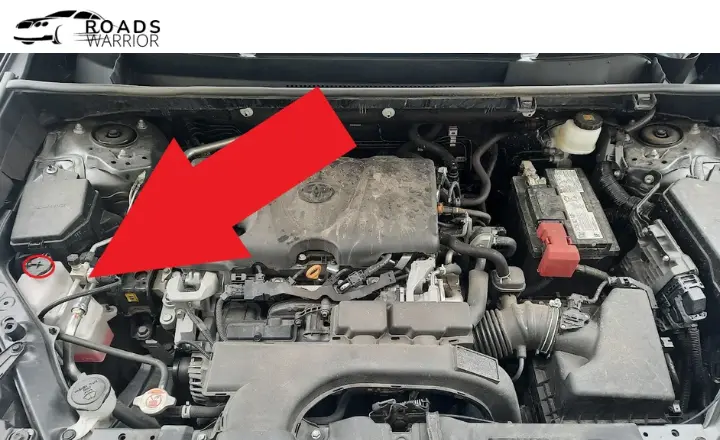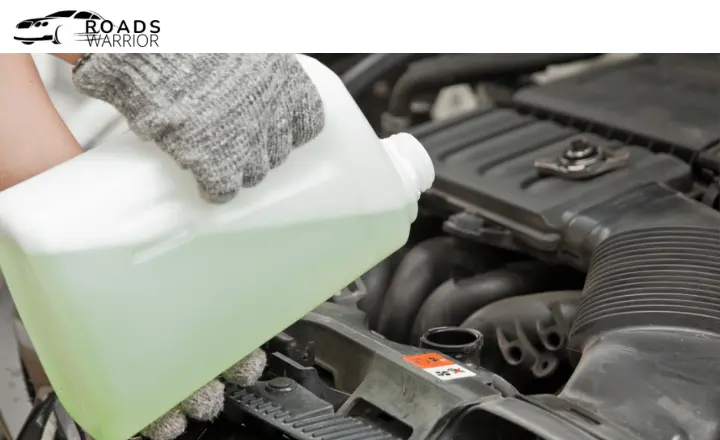Toyota RAV4 coolant is one of the most critical fluids in your RAV4 engine system. Without the proper Toyota RAV4 coolant level, mixture, and maintenance, your RAV4’s engine would quickly overheat, leading to significant engine damage or even failure.
Keeping your RAV4’s coolant in top shape is essential for protecting your investment and ensuring reliable performance.
In this blog post, we will look deeper at the function of coolant for Toyota rav4, when you should change and replace it, the different types of coolant approved for use in different model years, and simple steps to check and top up your coolant level. Properly maintaining your coolant for Toyota rav4 will go a long way in extending engine life and preventing any overheating headaches down the road.
UNDERSTANDING TOYOTA RAV4 COOLANT COOLANT

Engine coolant is known as antifreeze, but they are two different substances.
- Antifreeze is primarily made from ethylene glycol or propylene glycol and is the main ingredient in coolant.
- On the other hand, coolant is a mixture of antifreeze and water, typically in a 50-50 ratio.
- Some vehicles may require a different ratio, such as 70% antifreeze and 30% water for cold climates.
- The 50-50 coolant blend can protect the engine at temperatures exceeding 200 degrees Fahrenheit and as low as 30 degrees below zero.
Engine coolant and antifreeze serves multiple essential functions to maintain the proper functioning of a vehicle’s engine.
- One crucial role is to regulate the motor’s temperature, ensuring it does not overheat during operation.
- Coolant acts as a lubricant for the various moving parts within the engine, reducing friction and wear.
- Coolant also plays a critical protective role by preventing damage to components such as the head gasket, water pump, engine block, and cylinder head.
- Its anti-corrosive properties further safeguard the engine from deterioration caused by oxidation or rusting.
- The heat transfer capabilities of engine coolant facilitate the dispersion of excess heat away from the motor to maintain optimal operating temperatures.
This cooling process involves a closed system through which the coolant cycles, moving from the engine to the radiator and returning to mitigate overheating risks effectively.
CHECKING THE LEVEL

If your RAV4’s temperature gauge starts creeping into the hot zone, it’s not just a warning sign; it’s a red alert for potential disaster. Once that gauge hits the red zone, you’re playing with fire. The damage to the engine from overheating can be catastrophic and ridiculously expensive to repair. As a responsible RAV4 owner, monitoring the coolant level should be as routine as checking your oil or tire pressure.
Regarding checking your RAV4’s coolant level, location is everything. The large white container on the left side of the engine bay is where you’ll find the crucial coolant reservoir. But before you pop that cap open for a peek inside, remember this: never attempt to inspect or refill coolant when the engine is hot.
The pressure in the cooling system could lead to an unexpected spray of scalding fluid capable of causing severe burns. So always play it safe and give that engine ample time to cool down before taking further action with your coolant maintenance.
- Park your RAV4 on a level surface and use the brake to ensure safety.
- Turn off the engine before proceeding to check the coolant level.
- Open the hood cautiously, avoiding contact with hot radiators, hoses, or engine parts to prevent burns.
- Locate the coolant reservoir positioned to the left of the engine compartment.
- Check the side of the reservoir to gauge how much coolant is present, ensuring it meets the recommended level.
- If the reservoir appears dirty, use a cloth to wipe it off to see the coolant level.
- Be cautious throughout this process, as engine components may still be hot even after shutting off the vehicle.
Check the reservoir for coolant levels using the markings for full and low. If it’s between the lines when the engine is cold, there is no need to add coolant. If it’s below the low line, add more fluid. Remember to monitor the level regularly after topping off. Persistent drops may indicate a leak that needs fixing.
HOW OFTEN TO CHANGE

Maintaining the coolant system in your Toyota RAV4 goes beyond just topping off the fluid. While it may seem unnecessary if you’ve never had to add or flush the coolant, following Toyota’s recommendations is crucial for long-term engine health. The 15,000-mile or 18-month inspection intervals serve as preventative measures to catch any potential issues with the coolant early on, potentially saving you from costly repairs down the road.
Despite using extended-life Toyota Rav4 antifreeze or an extended-service formulation, it’s important to note that the maximum life of coolant remains at 120 months or ten years. This emphasizes the significance of adhering to Toyota’s flushing recommendations every 100,000 miles to ensure continued protection for your engine.
By staying proactive and following Toyota’s guidelines for maintaining your RAV4’s coolant system, you can avoid unexpected breakdowns and preserve your vehicle’s longevity. While it may seem like an added expense and effort now, these maintenance practices act as insurance for keeping your car running smoothly well into the future. As technology advances and vehicles become more complex, these seemingly simple tasks support overall performance and reliability.
CHOOSING THE CORRECT TOYOTA RAV4 COOLANT TYPE
It’s important to follow the manufacturer’s guidelines when maintaining your RAV4. The recommendations for oil type, tire pressure, and service intervals can vary depending on your vehicle’s specific model and year.
RAV4 GAS MODEL
- From 2004 to 2023, Toyota Super Long Life Coolant, comprising a 50/50 mixture of coolant and deionized water, was recommended.
- For the years 2000-2003, a 50% solution was advised for protection down to 35°C (31°F), while a 60% solution is suggested for protection down to around 50°C (58°F).
- It is cautioned against using more than a 70% solution for optimal coolant performance.
- Between 1996 and 1999, Toyota Long Life Coolant or an equivalent with ethylene glycol type coolant was specified.
It is advised to avoid alcohol-type antifreeze or plain water alone during this period.
A 50% solution was recommended to protect down to about 35°C (31°F).
RAV4 HYBRID MODEL
- From 2016 to 2023, Toyota used Super Long Life Coolant as its Toyota RAV4 recommended coolant.
- This specific coolant comprises a precise mixture of 50% coolant and 50% deionized water.
RAV4 PRIME MODEL
- From 2021 to 2023, Toyota recommends using Super Long Life Coolant in a 50/50 mixture with deionized water for optimal engine performance.
- This coolant provides superior protection against corrosion and rust within the cooling system.
- It is designed to withstand extreme temperatures and provide long-lasting cooling performance for the vehicle.
- The 50/50 mixture ensures heat transfer and freeze protection in varying climatic conditions.
COOLANT CAPACITY
Proper coolant levels are essential for the RAV4’s optimal performance and lifespan.
- Insufficient coolant can result in the engine overheating, causing irreversible damage.
- Without adequate coolant, vital components may not receive proper lubrication, increasing the risk of failure.
- Air entering the cooling system due to underfilling can lead to inefficiencies and potential malfunctions.
- Maintaining the correct coolant level prevents costly repairs and ensures smooth operation.
Overfilling the cooling system can have serious consequences that you’d want to avoid.
- Spilled coolant can end up on the engine and other components, potentially causing damage and affecting performance.
- Electronics within the vehicle may become damaged if too much coolant is added to the system.
- Excessive pressure from overfilling can lead to leaks, creating further issues and potential safety hazards.
- It’s crucial to adhere to filling the tank just below the FULL line to avoid these issues.
Based on information from Toyota, the total capacities for coolant should be followed to ensure proper operation of the vehicle’s cooling system.
RAV4 GAS MODEL
2000-2023:
- The engine oil capacity without an oil cooler is 7.3 quarts (6.9 liters, 6.1 imperial quarts).
- When equipped with an engine oil cooler, the capacity increases to 7.4 quarts (7.0 liters, 6.2 imperial quarts).
1996-1999:
- Manual transmission fluid capacity: 8.0 quarts (8.5 liters or 7.0 Imperial quarts)
- Automatic transmission fluid capacity: 7.7 quarts (8.1 liters or 6.8 Imperial quarts)
- The manual transmission requires approximately 8.0 quarts of fluid, while the automatic transmission needs about 7.7 quarts.
- Filling the manual transmission should take around 8.5 liters or 7 Imperial quarts of transmission fluid.
RAV4 HYBRID MODEL
2022-2023:
- The gasoline engine requires 6.4 quarts (6.1 liters or 5.4 imperial quarts) of oil for optimal performance.
- The power control unit necessitates 1.7 quarts (1.6 liters or 1.4 imperial quarts) of oil to function efficiently.
2019-2021:
- The gasoline engine requires 7.9 quarts (7.5 liters, 6.6 imperial quarts) of fuel for optimum performance.
- The power control unit needs 1.6 quarts (1.5 liters, 1.3 imperial quarts) of fluid to function effectively.
RAV4 PRIME MODEL
2021-2023:
The gasoline engine requires 8.7 quarts (8.2 liters, 7.2 imperial quarts) of fuel to operate efficiently.
The power control unit needs 2.1 quarts (2.0 liters, 1.8 imperial quarts) of fuel for proper functioning.
DOES COLOR MATTER?
Coolant comes in different colors, but the color doesn’t affect its function. The color shows what type of coolant it is. It’s essential to pick the right one because it affects your cooling system and engine. Using the wrong coolant can cause damage. Common colors include green, orange, pink, and yellow.
- Green coolant is typically utilized for standard automotive applications due to its compatibility with various vehicles.
- On the other hand, Orange coolant is specifically designed for heavy-duty applications and diesel motors, offering enhanced durability and performance in these types of engines.
- Pink coolant is formulated for use in newer vehicle models, featuring specialized additives that cater to the requirements of modern engines and cooling systems.
- Yellow coolant is commonly recommended for older vehicles as it addresses the specific needs of aging engine components and provides optimal protection against corrosion and wear.
COMMON COOLANT PROBLEMS
- The Toyota RAV4 is regarded as a reliable vehicle for coolant issues, but some users have yet to encounter problems.
- Loose hose connections, broken radiators, and failed water pumps are cited as the primary reasons for coolant leaks in the RAV4, according to RepairPal.
- User Aimepac’s experience of significant coolant loss without visible leaks raises questions about potential hidden issues with the vehicle’s cooling system.
- User BamZipPow’s suggestion of trapped air in the cooling system sheds light on another possible culprit for mysterious coolant loss in RAV4s.
- User PatFlynnEire’s unfortunate incident after having a costly overhaul emphasizes the importance of thorough inspection and repair work by dealerships.
CONCLUSION
Maintaining the proper RAV4 coolant level is essential for preventing overheating and ensuring smooth operation of the cooling system. By adhering to the recommended maintenance schedule and regularly checking the reservoir, you can proactively address any potential issues before they escalate. Taking care of your RAV4 is crucial for its longevity and reliability, especially if you embark on many adventures. If you encounter any concerns with the cooling system, don’t hesitate to seek professional inspection and assistance. With a bit of attention and care, your RAV4 will continue to serve you well for years.
